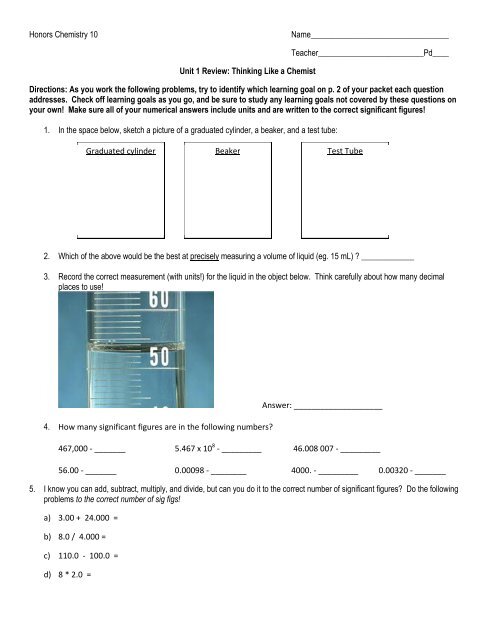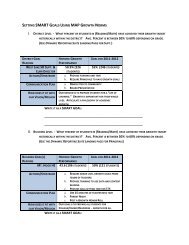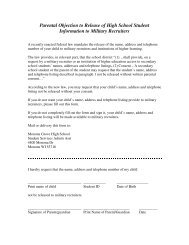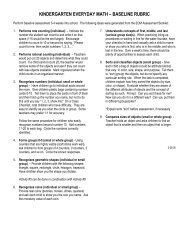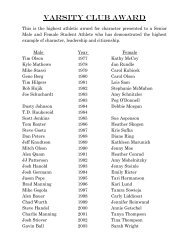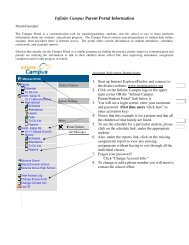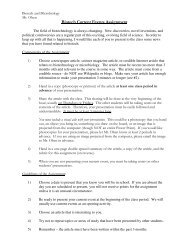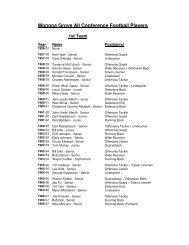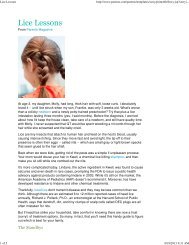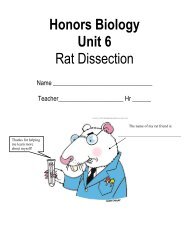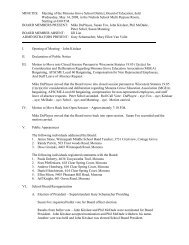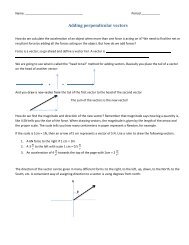Unit 1 Test Review Honors - Monona Grove Schools
Unit 1 Test Review Honors - Monona Grove Schools
Unit 1 Test Review Honors - Monona Grove Schools
Create successful ePaper yourself
Turn your PDF publications into a flip-book with our unique Google optimized e-Paper software.
<strong>Honors</strong> Chemistry 10<br />
Name__________________________________<br />
<strong>Unit</strong> 1 <strong>Review</strong>: Thinking Like a Chemist<br />
Teacher__________________________Pd____<br />
Directions: As you work the following problems, try to identify which learning goal on p. 2 of your packet each question<br />
addresses. Check off learning goals as you go, and be sure to study any learning goals not covered by these questions on<br />
your own! Make sure all of your numerical answers include units and are written to the correct significant figures!<br />
1. In the space below, sketch a picture of a graduated cylinder, a beaker, and a test tube:<br />
Graduated cylinder Beaker <strong>Test</strong> Tube<br />
2. Which of the above would be the best at precisely measuring a volume of liquid (eg. 15 mL) ? _____________<br />
3. Record the correct measurement (with units!) for the liquid in the object below. Think carefully about how many decimal<br />
places to use!<br />
4. How many significant figures are in the following numbers?<br />
Answer: ____________________<br />
467,000 - _______ 5.467 x 10 8 - _________ 46.008 007 - _________<br />
56.00 - _______ 0.00098 - ________ 4000. - _________ 0.00320 - _______<br />
5. I know you can add, subtract, multiply, and divide, but can you do it to the correct number of significant figures? Do the following<br />
problems to the correct number of sig figs!<br />
a) 3.00 + 24.000 =<br />
b) 8.0 / 4.000 =<br />
c) 110.0 - 100.0 =<br />
d) 8 * 2.0 =
5. Convert the following numbers into proper scientific notation:<br />
a) 463,000 = _________<br />
b) 56 = ________<br />
c) .0000078 = __________<br />
d) 0.950 = __________<br />
e) 108.75 x 10 4 = _________<br />
f) .985 x 10 8 = ____________<br />
g) 934.1 x 10 -9 = ____________<br />
6. Convert the following numbers into ordinary notation:<br />
a) 3.58 x 10 7 = ___________<br />
b) 4.54 x 10 2 = ___________<br />
c) 5.47 x 10 0 = ___________<br />
d) 4.44 x 10 -3 = ___________<br />
e) -5.74 x 10 3 = ___________<br />
7. Find the answers to the following without using a calculator. Show all work and circle your final answer!<br />
a) 5.0 x 10 4 * 1.0 x 10 6 e) 4.0 x 10 7 * 3.0 x 10 8<br />
b) 6.0 x 10 7 + 2.0 x 10 6 f) 6.0 x 10 -5 / 3.0 x 10 2<br />
c) 4.0 x 10 4 / 2.0 x 10 2 g) 8.0 x 10 -5 + 1.0 x 10 -6<br />
d) 8.0 x 10 3 – 5.0 x 10 2 h) (8.0 x 10 6 - 5.0 x 10 5 ) / 1.0 x 10 3<br />
8. a) During lunch last week, you were served a mysterious substance as your beverage. You take a sample back home<br />
with you, and find out that the mass of the liquid is 458 grams and the volume is 446.8 milliliters. In the space below, calculate<br />
the density of this mysterious object – use the method your teacher taught you in class to calculate the density!<br />
b) Using Figure 2.8 on p. 36 of your textbook, identify what this mystery substance is (NOTE: it is a clear substance)<br />
9. Find the mass of an object that has a density of 0.92 grams per milliliter and a volume of 55.7 milliliters. Again, use the<br />
method shown in class to do this problem!
10. What is the volume of a liquid that has a mass of 24.2 grams and a density of 1.2 grams per milliliter? Use the method shown<br />
in class to solve this problem.<br />
11. From the lab last week in class, you remember that the density of sand is equal to 1.60 grams per milliliter. If you weigh out<br />
20. grams of sand, what will the volume be?<br />
12. a) Using the table on p. 36 of your textbook, list the solids that will sink in water.<br />
b) Which solids listed in the same table will float in ethyl alcohol?<br />
13. Whoa! Jaden can bench 136 kilograms! How many ounces is this equal to (2.2 pounds = 1 kilograms; 16 ounces = 1<br />
pound)? Use conversion factors to solve this problem in the space below.<br />
14. Your friend from Switzerland needs help. She just moved here, and needs to know what 60 miles per hour is equal to in<br />
meters per second (the unit of choice in her country) so that she doesn’t speed on the beltline. Using conversion factors<br />
found on p. 16 of your packet, convert 60 miles per hour into meters per second in the space below.<br />
15. A fictional <strong>Monona</strong> <strong>Grove</strong> High School chemistry student was asked to gather data on the density of mercury (this is fictional<br />
because, unfortunately, mercury is poisonous and we don’t have any). She wanted to make sure she repeated her<br />
measurements 3 times to get good data. Below is her data table:<br />
Repetition Mass Volume Density Percentage Error<br />
1 25.2 g 1.73 mL 14.6 g/ml<br />
2 24.7 g 1.68mL 14.7 g/ml<br />
3 23.7 g 1.61 mL 14.7 g/ml<br />
a) What is the accepted value for the density of mercury (see p. 36 of your textbook).<br />
b) Would you say the density data are precise? Explain.<br />
c) Would you say the density data are accurate? Explain.<br />
d) Fill in the last column of the data table by calculating the percent error for each repetition.


